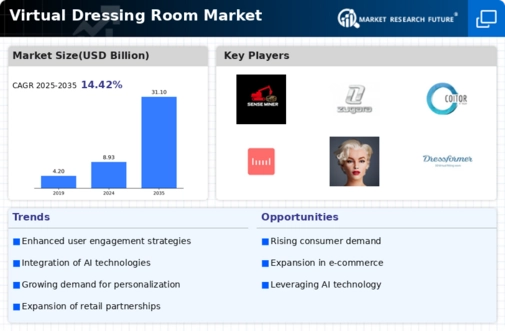Market Analysis
In-depth Analysis of Virtual Dressing Room Market Industry Landscape
The Virtual dressing room industry boom is currently driving through technological advancement and changing consumer behavior patterns. With the retail landscape evolving, demand for innovative solutions has resulted in the growing popularity of virtual fitting rooms. The growth in e-commerce is one of the main drivers behind this trend since consumers are increasingly turning online due to the ease with which they can browse and buy from home. Virtual dressing rooms address this problem, bridging between the online shopping experience and brick-and-mortar store experience where shoppers cannot try clothes before purchasing physically. Consequently, web-based platforms are integrating their systems with virtual dressing room technologies to enhance customer interaction and satisfaction. Additionally, the emerging trends in augmented realities (AR) and virtual realities (VR) have significantly influenced the market dynamics of virtual fitting rooms. These immersive technologies allow customers to see themselves in different outfits with remarkable realism, making shopping more interactive and enjoyable. Furthermore, market dynamics for virtual dressing rooms have also been shaped by the global fashion industry's inclination towards sustainability. Consumers are becoming increasingly aware of the environmental impact of excessive returns in online fashion. Soiled apparel is minimized through virtual dressing rooms, which enables clients to try on clothes, thereby lessening the number of shipments and returns virtually. Retailers recognize eco-benefits from such solutions and hence are including them as part of their sustainable business practices. Also, the increased use of cell phones and mobile devices is playing a significant part in shaping the virtual dressing room market. Growing more powerful and accessible, these devices empower customers to connect with virtual dressing room applications effortlessly. This trend has been embraced by retailers who are creating user-friendly mobile applications that offer virtual try-on capabilities. However, limitations such as technological bounds and concerns about privacy and data security are currently affecting the dynamics of the virtual dressing room market. Developers are constantly faced with the challenges of ensuring proper apparel fitting and realistic visualization. Moreover, purchasers may be reluctant to share their data or pictures when trying out clothes virtually, thus raising serious concerns about privacy and security, which must be addressed for widespread acceptance.











Leave a Comment